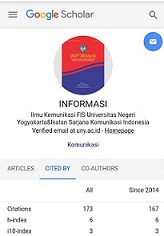Development of labor market information system in Indonesia towards world class
DOI:
https://doi.org/10.21831/informasi.v53i1.47615Keywords:
Labour Market Information System, Employment Information System, Roles and Functions of LMISAbstract
The demographic dividen can provide benefits for Indonesia. The proportion of the working age population in Indonesia until 2021 is reaching 205.36 million, which is 68.08% of the workforce. The labor force participation is 93.74%, with the informal sector as much as 59.6%, and the number of unemployed reaches 6.26%. The labourforce structure profile is a challenge for the Indonesian government to encourage the population to participate to industry. The developing of Labour Market Information System (LMIS) is one of the goverment to gather job seekers and employers with the final objective is to reduce unemployment. This study aims to evaluate and analyze the LMIS that has been developed by the Government of Indonesia and to formulate an LMIS development strategy to meets international standards. This study uses qualitative analysis methods. Sampling using purposive sampling technique by taking samples of several provinces that are categorized as densely industrialized and have a high unemployment rate. LMIS owned by Indonesia is still classified as basic level to middle class. Based on the problems that occur in LMIS development and the low level of utilization, the LMIS development method must be based on and pay attention to the needs of stakeholders.
References
Anonymous. (2015). "Indonesia: Sistem informasi dan Layanan Pasar Tenaga Kerja".
Anonymous. (2018). "Toward a World-Class Labor Market Information System for Indonesia."
Cahyohadi, S.M. (2021). "Implementasi Informasi Pasar Kerja Online Dalam Pelayanan Penempatan Tenaga Kerja (Kasus Dinas Tenaga Kerja Kabupaten Sleman)," J. Bina Ketenagakerjaan, vol. 2, no. 2, pp. 123–132.
Charles, Y. 2020 "Pemanfaatan Informasi Pasar Kerja Online dengan Seluruh Stakeholder," Tagar.id. https://www.tagar.id/pemanfaatan-informasi-pasar-kerja-online-dengan-seluruh-stakeholder (accessed Nov. 11, 2021).
Dariah, H. U. (2015). "Studi Tentang Pelayanan Informasi Pasar Kerja (IPK) Pada Dinas Tenaga Kerja Kota Samarinda," Adm. Negara (3). 2, pp. 158–168.
Fauzan, R. 2021. "Sistem Informasi Pasar Kerja Bakal Berdampak Signifikan, Asalkan...," Bisnis.com, 2021. https://ekonomi.bisnis.com/read/20210317/12/1368885/sistem-informasi-pasar-kerja-bakal- (accessed Nov. 11, 2021).
Fitrani, A, R. Rusdi, and Muhammad. (2011). "Pelayanan Penempatan Tenaga Kerja Pada Dinas Tenaga Kerja Kota Makassar," Pasca Sarj. Univ. Hasanudin, pp. 1–8.
Hariyati, A. As, and M. Dama. (2019). "Peranan Dinas Tenaga Kerja Dalam Penempatan Tenaga Kerja Dan Perluasan Kerja Di Kota Samarinda," Ilmu Pemerintah., vol. 7, no. 2, pp. 597–608.
Hasibuan, E., & Handayani, D. (2021). Pengaruh Qualification Mismatch terhadap Upah Tenaga Kerja Di Indonesia. Jurnal Ekonomi Dan Pembangunan, 29(1), 1–16. https://doi.org/10.14203/jep.29.1.2021.1-16
Husain, As. (2019). "Pelayanan Publik Pendaftaran dan Penempatan Pencari Kerja Berbasis TIK Di Kota Makassar."
Ikhsani, N. (2022). Analisis Faktor Bonus Demografi Terhadap Upaya Indonesia Keluar Dari Middle Income Trap Tahun 1990-2019.
Intan, N. (2021). "Bangun Sistem Informasi Pasar Kerja, RI Tiru Worknet Korsel," Republika.co.id. https://www.republika.co.id/berita/qxedx5383/bangun-sistem-informasi-pasar-kerja-ri-tiru-worknet-korsel (accessed Nov. 11, 2021).
Kusumawardani, K. A., & Richard, R. (2020). Family Comes First: An Investigation on Entrepreneurial Intention among Chinese Indonesian Gen Z. International Journal of Family Business Practices, 3(1), 39-54.
Mantra, I. (2003). Demografi umum. Pustaka Pelajar.
Marhaeni, A. I. K. Sudibia, I. G. W. M. Yasa, N. N. Yuliarmi, and N. P. M. Dewi. (2017). "Kondisi Pasar Kerja Di Provinsi Bali: Implementasi Undang-Undang Wajib Lapor Ketenagakerjaan Di Perusahaan," J. Bul. Stud. Ekon. (22). 2, pp. 175–186.
Martono, A. (2011). "Systems Analisys Of National Employment From The Technological Aspect And Working Mechanisms," Rekayasa Teknol.(2). 2, pp. 1–15.
Miles, M, A. Huberman, and J. Saldana. (2014). Qualitative Data Analysis, A Methods Sourcebook, 3rd ed. Sage Publications.
Pereira, A. da P. S., A. Hakim, and Suryadi. (2015). "Implementasi Program Sistem Informasi Pasar Tenaga Kerja (Sistema Informasaun Merkadu Trabalhu)," J. Ilmu Sos. dan Ilmu Polit., vol. 4, no. 262–271.
Prayudhani, O. (2020) "Peta Ketidaksesuaian Kualifikasi Sektoral di Indonesia", Jurnal Ketenagakerjaan, 15(2), pp. 140–154. doi: 10.47198/naker.v15i2.69
Santia, T. 2021. "Bappenas: Sistem Informasi Pasar Kerja Indonesia Masih Rendah," Liputan6.com. https://www.liputan6.com/bisnis/read/4565909/bappenas-sistem-informasi-pasar-kerja-indonesia-masih-rendah (accessed Nov. 11, 2021).
Setiyawan, B, I. Aknuranda, and A. D. Herlambang. (2018). "Analisis dan Perancangan Sistem Informasi Pelayanan Informasi Pasar Kerja Dengan Pendekatan Berorientasi Objek," J. Pengemb. Teknol. Inf. dan Ilmu Komput., vol. 2, no. 9, pp. 2721–2728.
Yani, D. D. A. (2017). "Website Infokerja-Kaltim.Com Sebagai Media Informasi Pasar Kerja Di Dinas Tenaga Kerja Dan Transmigrasi Provinsi Kalimantan Timur," Ilmu Komun., vol. 5, no. 1, pp. 296–310.
Downloads
Published
Issue
Section
License
Authors who publish with this journal agree to the following terms:- Authors retain copyright and grant the journal right of first publication with the work simultaneously licensed under a Creative Commons Attribution License that allows others to share the work with an acknowledgement of the work's authorship and initial publication in this journal.
- Authors are able to enter into separate, additional contractual arrangements for the non-exclusive distribution of the journal's published version of the work (e.g., post it to an institutional repository or publish it in a book), with an acknowledgement of its initial publication in this journal.
- Authors are permitted and encouraged to post their work online (e.g., in institutional repositories or on their website) prior to and during the submission process, as it can lead to productive exchanges, as well as earlier and greater citation of published work (See The Effect of Open Access).




















